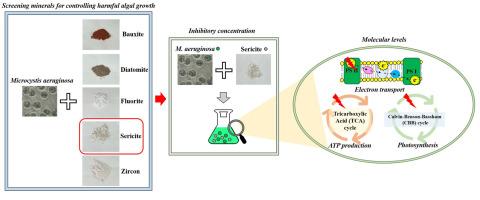Effects of mineral resources on the growth of the harmful algal species Microcystis aeruginosa: From screening to understanding the underlying mechanisms
IF 8.4
2区 环境科学与生态学
Q1 ENVIRONMENTAL SCIENCES
引用次数: 0
Abstract
The bloom-forming toxic cyanobacterium Microcystis aeruginosa synthesizes multiple secondary metabolites that pose significant risks to human health. Consequently, various studies have focused on strategies to control the growth of M. aeruginosa. However, little is known about the effect of natural minerals on the physiological activity of M. aeruginosa. This study aimed to investigate the potential of diverse natural minerals for controlling harmful cyanobacterial growth. Among the five tested candidates, sericite exhibited the most pronounced inhibitory effect on growth of M. aeruginosa. Notably, photosynthetic activity decreased significantly as sericite concentrations increased, likely due to the inhibition of the electron transport pathway. To elucidate the underlying inhibitory mechanisms, transcriptome analysis was conducted, identifying 88 differentially expressed genes. Among them, several genes associated with inorganic ion transport, metabolism, energy production and conversion were up-regulated in the sericite cultures, suggesting that sericite may have induced cellular stress. This stress would likely disrupt cellular homeostasis and energy production, resulting in growth inhibition. This study offers new insights through a comprehensive investigation of the molecular-level effects of sericite on the growth of M. aeruginosa, and highlights the potential use of natural minerals for environmentally sustainable control of harmful algal blooms.

矿产资源对有害藻类铜绿微囊藻生长的影响:从筛选到了解其潜在机制
形成水华的有毒蓝藻绿微囊藻合成多种次生代谢物,对人类健康构成重大风险。因此,各种研究都集中在控制绿脓杆菌生长的策略上。然而,天然矿物质对铜绿假单胞菌生理活性的影响尚不清楚。本研究旨在探讨不同天然矿物质在控制有害蓝藻生长方面的潜力。其中绢云母对铜绿假单胞菌生长的抑制作用最为显著。值得注意的是,随着绢云母浓度的增加,光合活性显著降低,这可能是由于电子传递途径受到抑制。为了阐明潜在的抑制机制,进行了转录组分析,鉴定了88个差异表达基因。其中,与无机离子运输、代谢、能量产生和转化相关的几个基因在绢云母培养中表达上调,表明绢云母可能诱导了细胞应激。这种压力可能会破坏细胞内稳态和能量产生,导致生长抑制。本研究通过全面研究绢云母对铜绿假单胞菌生长的分子水平影响提供了新的见解,并强调了天然矿物质在环境可持续控制有害藻华方面的潜在应用。
本文章由计算机程序翻译,如有差异,请以英文原文为准。
求助全文
约1分钟内获得全文
求助全文
来源期刊

Journal of Environmental Management
环境科学-环境科学
CiteScore
13.70
自引率
5.70%
发文量
2477
审稿时长
84 days
期刊介绍:
The Journal of Environmental Management is a journal for the publication of peer reviewed, original research for all aspects of management and the managed use of the environment, both natural and man-made.Critical review articles are also welcome; submission of these is strongly encouraged.
 求助内容:
求助内容: 应助结果提醒方式:
应助结果提醒方式:


